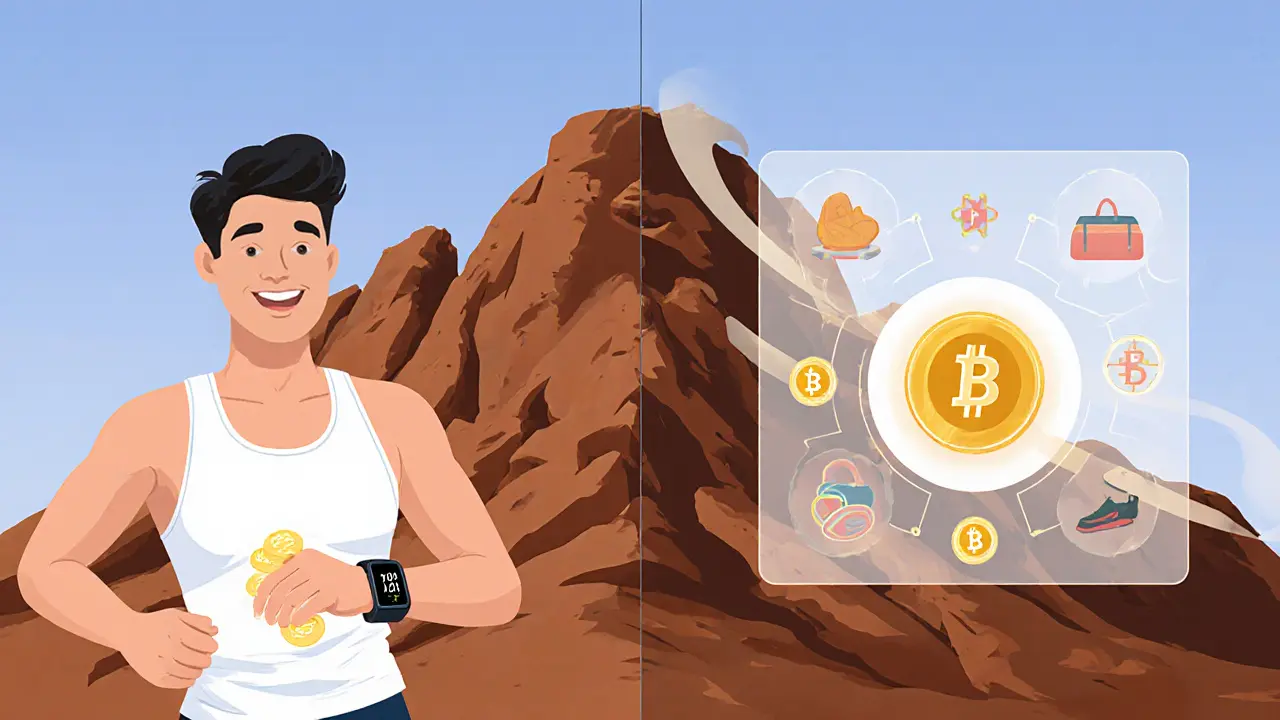Best Utility Tokens for Investment in 2025: Real-World Use Cases That Deliver Value
 Jan, 11 2025
Jan, 11 2025
Utility Token Value Calculator
Calculate Your Token Potential
Estimate potential value based on real-world usage metrics and adoption projections from the article.
Results will appear here after calculation
How this works: Based on data from the article, utility tokens with strong real-world adoption (like Propy and io.net) showed 20-50% annual growth. This calculator uses compound growth to estimate potential value.
Note: This is for educational purposes only. Actual results may vary based on market conditions and project adoption.
Not all crypto tokens are created equal. While meme coins rise and fall on Twitter hype, utility tokens are built to do something real. They give you access to services - whether it’s borrowing money, renting computing power, or buying property - all powered by blockchain. This isn’t speculation. It’s functionality. And in 2025, the best utility tokens aren’t just trading higher; they’re being used by millions every day.
What Makes a Utility Token Worth Investing In?
A utility token isn’t a share of a company. It doesn’t pay dividends. It doesn’t represent ownership. What it does is unlock access. Think of it like a prepaid card for a digital service. You buy the token, and you can use it to pay for features on that platform. The more people use the service, the more demand there is for the token. Simple. The key is real adoption. A token with 10,000 users doing actual transactions is more valuable than one with 1 million holders who just HODL. Look at Ethereum-based tokens - they power 58% of all utility token projects. Why? Because Ethereum’s infrastructure is stable, secure, and widely supported. Even with higher fees than newer chains, developers keep building on it because it works. Here’s what separates the winners from the losers:- Real-world use case: Does the token solve a problem people actually have? Real estate, AI computing, lending - these are tangible needs.
- Active usage: Are people using the service daily? Check daily transaction volume and active wallets.
- Tokenomics: Is the supply capped? Are tokens burned? Is there a clear incentive for holding or using it?
- Team and audits: Has the project been audited by reputable firms? Are the developers transparent?
According to CoinLedger’s September 2025 analysis, 78% of new utility tokens fail within 18 months. The ones that survive? They’re not trying to be the next Bitcoin. They’re trying to be the next PayPal for a specific job.
The Top Utility Tokens Driving Real Adoption in 2025
Ethereum: The Foundation of Utility
You can’t talk about utility tokens without talking about Ethereum. It’s not a token you buy to spend - it’s the platform most utility tokens run on. With a $501 billion market cap and a price near $4,150, Ethereum is the backbone of DeFi, NFTs, and real-world asset tokenization. The Pectra upgrade in May 2025 slashed gas fees by 47% and made Layer-2 integrations smoother. That means tokens built on Ethereum are cheaper and faster to use than ever. Aave, Uniswap, and Compound all run on Ethereum. Their tokens (AAVE, UNI, COMP) aren’t just for trading - they let you vote on protocol changes, earn interest, or provide liquidity. Aave alone holds $13 billion in total value locked (TVL). That’s real money being borrowed and lent through smart contracts.Propy (PRO): Tokenizing Real Estate
Buying a house across borders used to mean weeks of paperwork, wire transfers, and legal headaches. Propy changes that. Its PRO token is used to pay for property transactions on its platform. Since 2021, it’s processed over $4 billion in real estate deals across 15 countries. In 2025, it’s integrating with 12 more national land registries. PRO holders get discounts on transaction fees and can vote on which countries get added next. The token’s market cap sits at $70 million - small compared to Ethereum, but growing steadily. What’s impressive? During the 2022-2023 crypto winter, Propy’s transaction volume didn’t drop. People still needed to buy homes. That’s utility.io.net (IO): Decentralized AI Power
Training AI models needs massive computing power. Companies like OpenAI and Anthropic spend millions on GPU clusters. io.net lets anyone rent out their idle GPUs - from gamers to data centers - and get paid in IO tokens. As of October 2025, the network connects over 30,000 GPU clusters. That’s more than most cloud providers. Developers pay in IO to run AI workloads. The token’s market cap is $117 million. It’s not the biggest player - Render Network (RNDR) has 3.2x more adoption - but io.net is growing fast. Its advantage? Lower cost and direct peer-to-peer access. No middlemen. No corporate lock-in. Users report 23% face setup issues with GPU configuration, but the platform’s developer tools are improving fast. If AI infrastructure is the next big wave, io.net is building the boats.BlockchainFx (BLFX): Multi-Chain Trading Engine
Most crypto trading platforms work on one chain. BlockchainFx works across Ethereum, Solana, and BNB Chain. Its BLFX token gives users discounted trading fees and access to its AI-powered trade engine, which analyzes market patterns across all three networks. The platform processes $87 million in daily volume - not Uniswap-level, but solid for a newer player. It offers 18% APY on staked BLFX tokens, which is attractive. But here’s the catch: customer support is slow. Over 30% of users on CoinMarketCap complained about delayed responses. If you’re a high-frequency trader, this could be a problem. Still, its multi-chain approach is smart. As more chains emerge, users won’t want to switch wallets. BlockchainFx lets them stay in one place.Best Wallet Token (BEST): The All-in-One Crypto Wallet
Wallets are the gateway to crypto. But most wallets are clunky. Best Wallet Token (BEST) aims to fix that. It’s not just a wallet - it’s a hub for swapping, staking, and accessing dApps across Ethereum, Solana, and BNB Chain. With a 1.5-hour average setup time, it’s one of the easiest wallets to get into. It’s got a clean mobile app and supports over 1,200 tokens. But here’s the downside: 0.8% transaction fee. That’s 8-12% higher than Trust Wallet or MetaMask. Why charge more? The team says it funds development and security audits. And yes - they’ve had two independent audits, which is more than 63% of utility tokens can claim. Trust Wallet has 30 million users. BEST has 1.2 million. It’s not the leader - but it’s gaining traction among users tired of juggling five different apps.LivLive (LIV): Fitness Meets Blockchain
This one’s different. LivLive combines fitness tracking with blockchain rewards. You wear a smartwatch, complete workouts, and earn LIV tokens. Those tokens unlock premium training plans, discounts on gear, or even cash payouts. Unlike most crypto fitness apps that die after six months, LivLive has a 78% monthly retention rate. Why? Because it’s not just a token reward system - it’s a habit-building tool. Users report better workout consistency. CEO Michael van de Poppe says the model could deliver 50x returns by 2027 if adoption keeps growing. It’s not a huge market cap yet - under $50 million - but the user engagement is what matters. People aren’t buying LIV to flip it. They’re buying it to get fitter.
How to Choose the Right Utility Token for You
You don’t need to buy them all. But you do need to pick wisely.- Start with infrastructure: Ethereum, Solana, and BNB Chain tokens are the safest bet. They’re the plumbing of the crypto world.
- Look for real usage, not hype: Check DappRadar or CoinGecko for daily active users. If it’s under 10,000, tread carefully.
- Avoid tokens with no clear roadmap: If the whitepaper says “we’ll do amazing things,” but has no dates or milestones - walk away.
- Understand the risks: Even good tokens can crash if the whole market drops. Don’t put more than 5-10% of your portfolio into any single utility token.
According to ZebPay’s October 2025 risk model, utility tokens with strong utility-function alignment have an 83% survival rate through the next market cycle. Tokens without clear use cases? Only 37% make it.
What’s Next for Utility Tokens?
The future isn’t about more tokens. It’s about better integration. - AI + Blockchain: io.net and similar projects will keep growing as AI demands more compute power. - Real-world assets: Propy is just the start. Expect tokens for carbon credits, art, and even small business loans. - Regulation: The EU’s MiCA framework is clear. The U.S. SEC is still figuring it out. Projects are moving to Switzerland and Singapore to stay ahead. - Institutional adoption: BlackRock and Fidelity are watching. If they start buying utility tokens at scale, prices will surge.Deloitte predicts utility tokens will underpin 15-20% of global digital transactions by 2030. That’s not fantasy. That’s the direction we’re already moving.

Common Mistakes to Avoid
- Buying based on price alone: A $0.01 token isn’t a bargain if it has no users. A $10 token with 500,000 daily users is worth more.
- Ignoring gas fees: Ethereum tokens can cost $5 to swap during peak times. Solana tokens cost pennies. Factor this in.
- Not using the service: If you’re not actually using the token for its intended purpose, you’re just speculating. And that’s risky.
- Overlooking security: Always check if the project has been audited. Use multi-signature wallets for large holdings.
David Shapiro from Money.com put it bluntly: “78% of new utility tokens fail because their tokenomics are broken.” Don’t be one of the 78%.
Final Thoughts
Utility tokens are the quiet workhorses of crypto. They don’t trend on TikTok. They don’t have celebrity endorsements. But they’re the reason blockchain is moving beyond gambling. The best ones in 2025 aren’t the flashiest. They’re the ones solving real problems - helping people buy homes, rent GPUs, trade across chains, or stay fit. They’re not here for a quick flip. They’re here to stay. If you want to invest in utility tokens, don’t chase pumps. Chase purpose. Find the tokens that people actually use - and hold them as long as they keep delivering value.What’s the difference between a utility token and a security token?
A utility token gives you access to a product or service - like paying for cloud computing or voting on a protocol. A security token represents ownership in an asset, like shares in a company. Securities are heavily regulated. Utility tokens operate in a gray area, especially in the U.S., where the SEC sometimes claims they’re unregistered securities if they promise profits.
Can utility tokens make you rich?
Some have. Aave grew 14x in 2025. LivLive could hit 50x by 2027, according to analysts. But most won’t. The key is timing and use case. Tokens tied to real adoption - like Propy or io.net - have higher survival rates. Tokens with no users or vague promises almost always fail. Don’t expect get-rich-quick results. Think long-term value.
Which blockchain is best for utility tokens in 2025?
Ethereum still leads with 58% market share, thanks to its security and developer tools. But Solana is catching up fast with 22% - thanks to 65,000 transactions per second and fees under $0.00025. BNB Chain is popular for lower-cost apps. The best choice depends on your use case: Ethereum for stability, Solana for speed, BNB for affordability.
How do I buy utility tokens safely?
Use a reputable exchange like Coinbase, Kraken, or Binance for major tokens. For smaller ones, use decentralized exchanges like Uniswap or Raydium. Always connect your wallet (like MetaMask) directly - never give away your private keys. Start with small amounts. Check if the token has been audited and if the team is doxxed (publicly known). Avoid tokens with anonymous teams or no code on GitHub.
Are utility tokens regulated?
It depends. The EU’s MiCA law clearly defines utility tokens and sets rules for issuance. In the U.S., the SEC hasn’t settled on a clear framework. Some utility tokens have been labeled as unregistered securities. Projects now often incorporate in Switzerland or Singapore to avoid U.S. regulatory risk. Always check the legal status before investing.
What’s the biggest risk with utility tokens?
The biggest risk isn’t price volatility - it’s failure to gain adoption. Even a technically perfect token can die if no one uses it. Other risks include smart contract bugs, poor tokenomics (like unlimited supply), and regulatory crackdowns. Do your homework. Look at daily active users, transaction volume, and team transparency. If those are weak, walk away.
Martin Doyle
November 27, 2025 AT 02:05Finally, someone who gets it. Most people think crypto is about flipping memecoins, but real value comes from utility. Propy’s $4B in real estate deals? That’s not a bubble - that’s infrastructure. Ethereum’s Pectra upgrade made gas fees bearable, and now we’re seeing actual adoption, not just HODLing. This isn’t gambling - it’s the future of finance.
Tom MacDermott
November 28, 2025 AT 07:45Oh please. You’re acting like Ethereum isn’t just a glorified ATM for degens. 58% market share? Yeah, because everyone’s too lazy to learn Solana’s syntax. And Propy? Still processing deals in 15 countries while the rest of the world moves to tokenized carbon credits and AI microservices. You’re clinging to 2021 like it’s still the Renaissance.